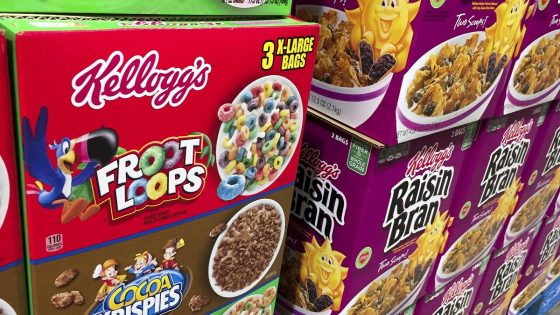Americans are spending more money on food than they have in 30 years, and Kellogg’s CEO Gary Pilnick has a solution: Eat cereal for dinner. The suggestion, made by Pilnick during a TV interview last week, gained widespread attention, dividing the internet.
Pilnick was making the case for “quite affordable” cereal during an appearance on CNBC’s “Squawk on the Street.”
In general, he said, “the cereal category is a place that a lot of folks might come to because the price of a bowl of cereal with milk and with fruit is less than a dollar. So you can imagine why a consumer under pressure might find that to be a good place to go.”
When anchor Carl Quintanilla asked if the suggestion of cereal for dinner has the “potential to land the wrong way,” Pilnick said: “We don’t think so. In fact, it’s landing really wall right now.”
He said Kellogg’s data shows cereal is not only the number one choice for breakfast at home, but 25% of cereal consumption is outside of breakfast time, like for dinner or a snack. “Cereal for dinner is something that is probably more on trend now and we would expect to continue as that consumer is under pressure.”
Anchor Courtney Reagan admitted that, as a busy mom, she has eaten cereal for dinner, but Plinick’s comments got a mixed reaction online. Some questioned if the CEO himself would feed his family cereal for dinner, while others said they have always done it and don’t see why it’s problematic. Some raised concerns about the nutrition of cereal and questioned if it really is affordable.
While the price of cereals declined 0.3% in 2023, it had increased in previous years – 6% for breakfast cereals in 2021 and 13% for breakfast cereal in 2022, according to the consumer price index from the U.S. Bureau of Labor Statistic.s
But it’s not just cereal that saw a price hike during recent inflation. According to data from the U.S. Department of Agriculture, in 2023, the price of fats and oils rose the fastest: 9%. In 2023, sugar and sweets increased 8.7% and cereals and bakery products increased 8.4%. Some food categories grew more slowly than historic averages, including beef, eggs, fruits and vegetables. And pork was the only category to decline, by 1.2%.
In 2022, U.S. consumers spent more than 11% of their disposable income on eating, whether at home or at a restaurant, according to the latest data from the FDA. And by the end of 2023, consumers were paying nearly 20% more for the same amount of groceries as they were in 2021, according to the latest index data
Inflation may be slowing, but food prices continue to increase, with groceries increasing 1.2% annually, and restaurant prices increasing 5.1% annually, according to the index.
Boston College economics professor Peter Ireland told CBS Boston food and energy prices have been rising at rapid rates, but wages have not kept up. “We had forgotten about just how costly and painful inflation is, especially for our most vulnerable people on fixed incomes,” he said. “If food and energy prices are rising more rapidly than incomes, it leaves less to spend on other things.”
Source Agencies



